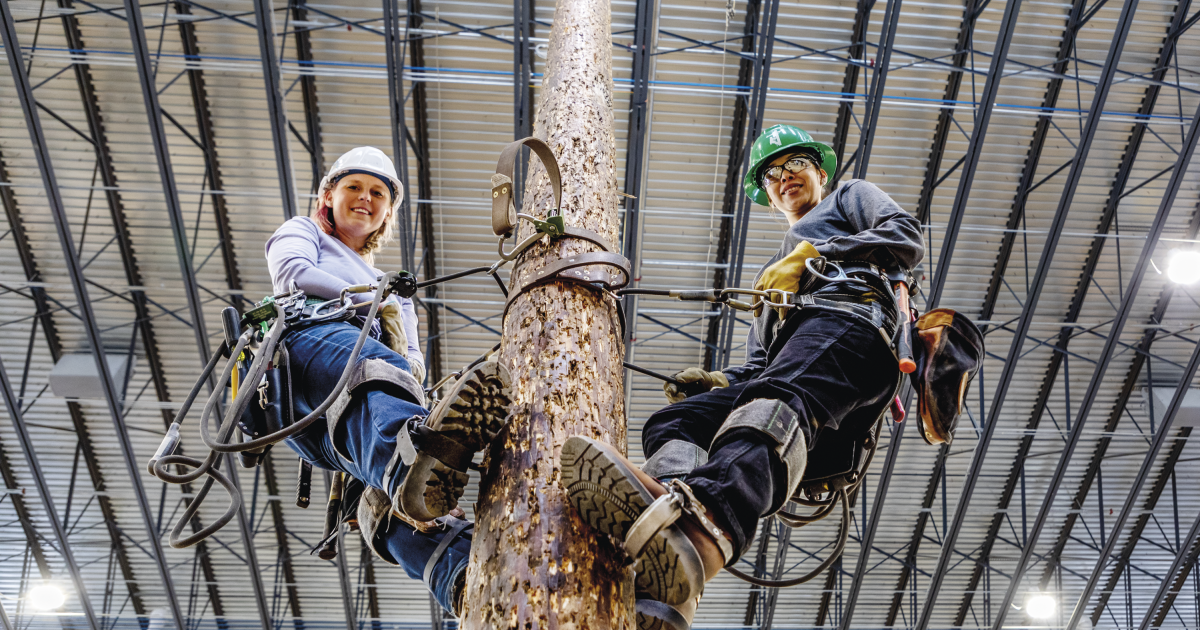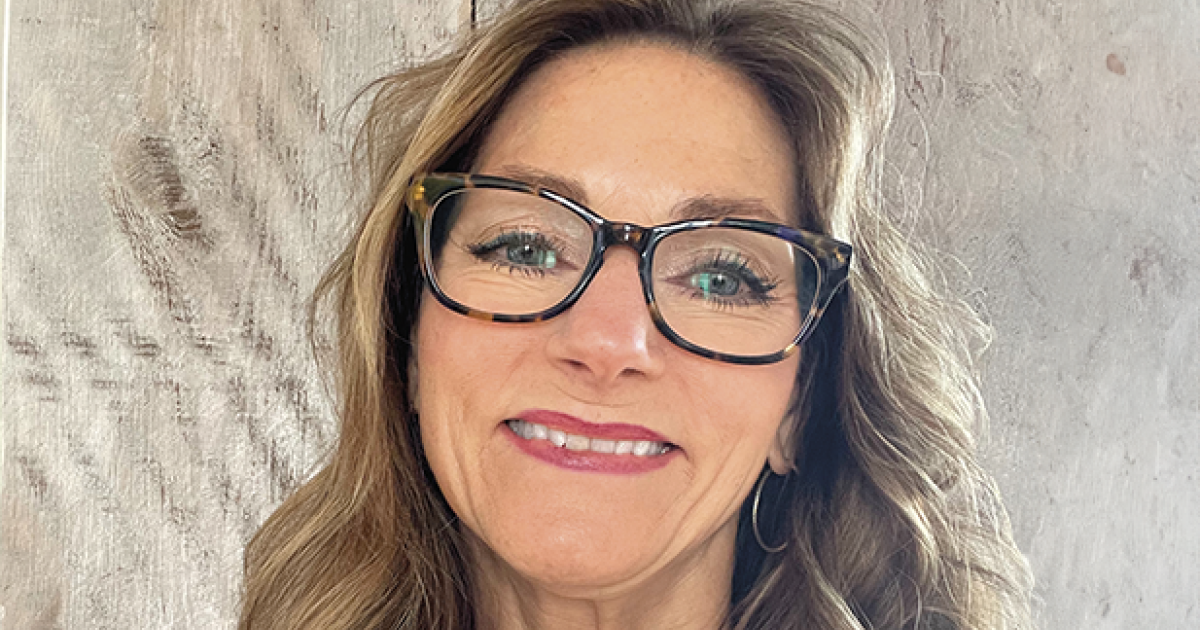WOMEN CLIMB TO NONTRADITIONAL CAREERS
Brooke Hilzendeger and Javonn Robertson. Photo by NDAREC/Liza Kessel
It’s a Friday afternoon, and Brooke Hilzendeger plops a heavy bag on the dirt floor of the Lineworker Training Center in Mandan, kicking up a trail of dust. She opens it and pulls out climbing boots, a body belt, a pole strap, gloves and a hard hat. These aren’t the items most people would expect to find in a woman’s bag, but for those who know Hilzendeger, a 29-year-old single mom and self-proclaimed tomboy, it comes as no surprise.
“A desk job really wasn’t for me,” Hilzendeger says. “I was going to go to welding school, but I was talking to some friends, and they said, ‘What about that Bismarck State College (BSC) lineworker program?’ I looked it up, and I was like, ‘Yeah. That’s what I want to do.’”
BSC’s lineworker program – the only one of its kind in North Dakota – educates students to become skilled apprentice lineworkers. Students in the intense, nine-month program learn how to set and climb poles and receive instruction in all facets of power line construction, equipment operation and maintenance. It’s a physically demanding profession, and it’s typically dominated by men.
“I was very nervous on the first day of school,” Hilzendeger says. “I was worried about being the only girl in class and how heavy things were going to be. And was I going to be able to climb at all? And now, here we are, halfway through, and I’m doing it.”
As it turns out, Hilzendeger wasn’t the only female to enroll in the program. Javonn Robertson, 26, also decided to take her career to new heights. But first, she had to overcome one of her biggest fears. Last summer, during a three-week introductory course, Robertson strapped on a climbing belt, and slowly ascended a 35-foot pole.
“I wanted to overcome (my fear of heights). And, being on a pole, more than 30 feet in the air, I realized I wasn’t afraid. It was a proud moment,” Robertson recalls. “After I overcame that fear, I knew I wanted to do this.”
Pole climbing is one of the first skills a lineworker student learns. To climb utility poles, which are anywhere from 30 feet to 120 feet high, lineworkers use special spikes, called gaffs, positioned on the outside of their feet. Using a pole belt and body belt to prevent themselves from falling, they lean back and stomp the gaffs into the pole, one foot at a time, as they climb. Of course, that’s much easier said than done. When climbing a pole, lineworkers wear gear that weighs between 20 and 30 pounds.
“Climbing doesn’t come easy for everyone. It doesn’t matter if you’re male or female,” says Brad Anderson, BSC’s lead lineworker instructor. “We lose five or six students every summer, because they just don’t want to do it. That fear of heights or falling – some people are able to work through it. Others want nothing to do with it. And, you have to be in pretty good shape to climb a pole. But, as long as you’re strong enough, and you’re not afraid, you can do it.”
Robertson, who previously worked as a welder, remembers the first time her mom saw her climb a pole.
“She came to my open house, and she was proud of me, but scared. She was clenching something the whole time,” Robertson says. “She said she thought welding was dangerous, but then I came up with a scarier idea. When I told her I was going to be a lineworker, she said, ‘Oh, God, no.’ She says I never stop surprising her.”
Every week, Robertson and Hilzendeger lace up their work boots and join their male classmates in the arena, where they face the challenges of a dangerous profession.
“You’ve got three things that most people don’t want to do on a daily basis. You’re going to be driving, you’re going to be working with heights, and you’re going to be working with electricity every day,” Anderson says.
It’s a fast-paced program, and they’re always learning something new.
“(Hilzendeger and Robertson) are great students. They show up and do exactly what they’re asked to do. And the more they do it, the better they get,” Anderson says. “I don’t really notice a difference between the male and female students in the field. They all just kind of mix in, I guess.”
When this year’s class graduates in May, Hilzendeger and Robertson will be among them. And they’re excited to take the next step. While they’re not sure where they’ll end up, they both look forward to the challenges ahead.
“My goal is to work under a helicopter one day,” Hilzendeger says. “In places like Alaska, if you can’t get there by truck, they’ll bring you in by helicopter. You’re basically connected to the helicopter by a rope. You stand there, on top of the equipment, and you do the work.”
And Robertson? She has her eyes set on a new area code.
“I’m getting my commercial driver’s license (CDL), and I want to travel. I’ve been in North Dakota my whole life. I want to get out and see what’s out there … and do some work at the same time.”
STUDENTS PURSUING NONTRADITIONAL CAREERS
Line work isn’t the only trade that’s attracting women. In 2021, the number of women working in trades occupations reached the highest level ever, at just over 314,000, according to the Institute for Women’s Policy Research.
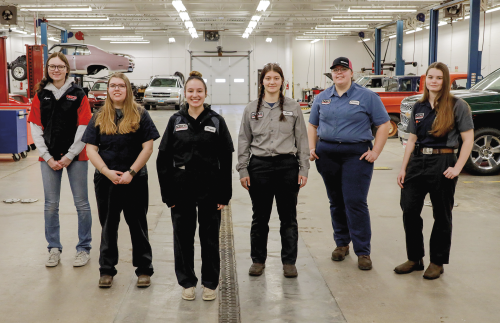 Daycee Preston, third from left, is pursuing a career in automotive technology at NDSCS. |
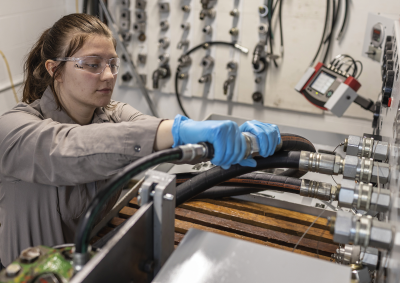
|
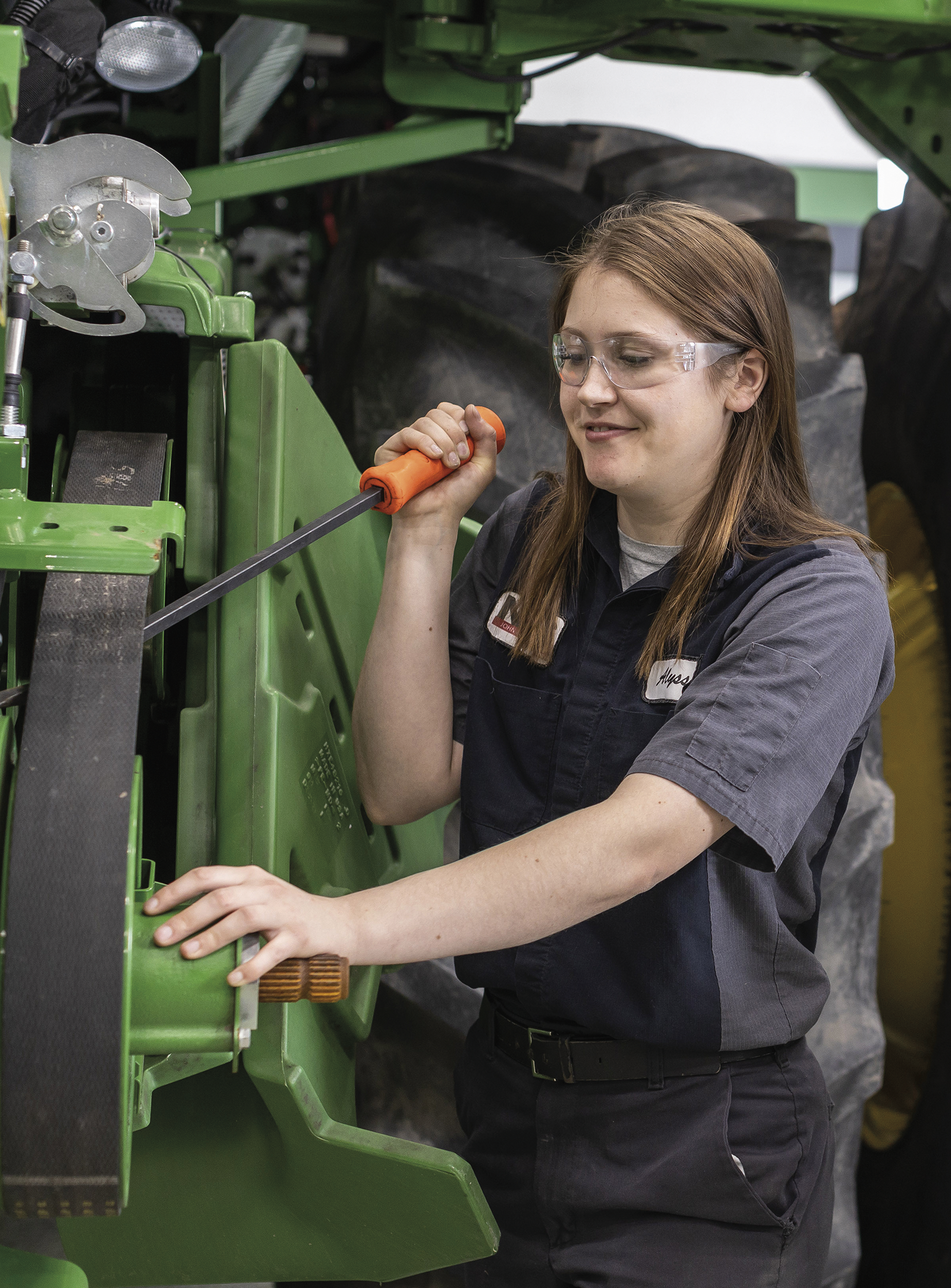
|
| Women interested in nontraditional careers, like automotive technology and electrical linework, are finding education opportunities at North Dakota colleges. |
United Tribes Technical College (UTTC) automotive technology instructor Darrin Starck says he’s seeing an uptick in females enrolled in the college’s automotive technology program. This year, he has one returning and three new female students. While those numbers are small, so is the class. With an average class size of about eight students, females are well represented. And Starck says they typically excel in the program.
“Women tend to have better diagnostic abilities than men,” Starck says. “Guys tend to jump in and take things apart, but they need to diagnose the problem first. I’ve found that female students will follow the rules and the diagnostic procedures properly before taking things apart.”
Those diagnostic abilities are crucial to an evolving industry. Automotive technicians face a challenging future due to the increased complexity of electronically controlled components. That’s why students in UTTC’s automotive technology program learn both the theory and technical skills needed to enter the automotive repair job market. Students spend half of their day in the classroom. The other half is spent working on cars in the college’s state-of-the-art training facility.
Shavonne Two Bears, who grew up fixing cars with her father, is now in her second semester of the program. She says she’s learned a lot already.
“Last semester, we tore apart an engine, and took out the pistons and stuff. It was quite interesting,” she says. “This semester, we're working on transmissions and electrical components, and then after midterm, we'll be doing power steering and suspension.”
After graduating high school, Two Bears initially planned to pursue a career in culinary arts, but after identifying a need within her community, she switched directions.
“The women in my community and my tribe need female mechanics to advocate for them,” Two Bears says. “I’ve seen grandmas and aunties get taken advantage of, and I want to be that go-to person for them. Someone they can trust.”
According to Dr. Lisa Karch, vice president for academic affairs and chief academic officer at the North Dakota State College of Science (NDSCS) in Wahpeton, career exploration starts at a young age.
“It starts in kindergarten or first grade, when a fire truck shows up. Or, maybe they have an opportunity to get under the hood of a car and learn what that looks like,” Karch says. “Many of the women I’ve talked to have a family member or a close friend who influenced their decision to go into the career field they chose.”
For Daycee Preston, this rings true. Like Two Bears, she is also pursuing a career in automotive technology. Now in her second year at NDSCS, she’s been working on cars since she was a kid.
“My dad actually got me into it,” Preston says. “He’d always bring around classic project cars, like ‘79 and older. And, I would always spend time with him and work on them. So, when it was time to make a career choice, I thought, ‘Well, I really like working on vehicles. So, I'll go with that.’”
Karch says these experiential situations help females envision a future in a nontraditional profession – professions in which they comprise less than 25% percent of the workforce.
“We learn from what we see, hear and observe. If you can’t picture yourself doing it, you’re not likely to pursue it,” Karch says. “That’s why we need to talk to young girls or adult learners who are changing career paths. Through educational videos, interviews, mentoring or apprenticeships, they can see what these professions actually look like.”
Many North Dakota high schools offer a variety of technical education courses, such as carpentry, automotive technology or welding, which provide female students with an opportunity to explore nontraditional professions. But Karch feels it’s important to expose students to these opportunities at a younger age, starting with elementary school.
“Let’s flip the narrative. Let’s explore your passions. What gets you excited? A lot of young women in the automotive or electrical courses never thought they could do it. And look at them now!” Karch says. “I love seeing women in these fields. Their excitement and their passion come alive when they're successful. And more importantly, I get more and more excited for the next generation of young girls, who see these women in these professions – women who are leaders for our next generation.”
For Hilzendeger, it’s not the women of tomorrow she hopes to inspire; it’s her son.
“I want my son to know that girls can do anything that guys can do,” Hilzendeger says. “I want to set an example. Anybody can do anything.”
Krista Rausch is a communications specialist with the North Dakota Association of Rural Electric Cooperatives. She can be reached at krausch@ndarec.com.


